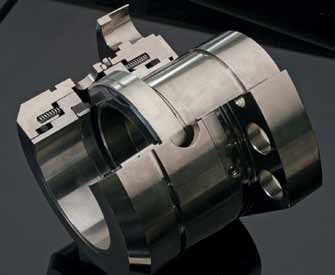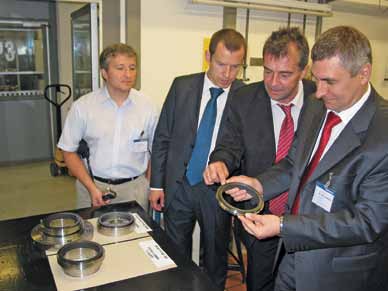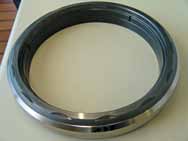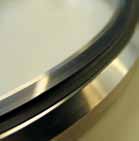Tailored sealing solutions supply high-pressure sealing for Russia's East Siberia Pacific Ocean pipeline system.
The East Siberia Pacific Ocean (ESPO) is a project of superlatives. The state-owned Russian company TransNeft is in the process of building the ESPO Pipeline in two phases. The 5,000 kilometer pipeline will supply Siberian oil to China, Japan and Korea. Completion and operation at full capacity are scheduled for 2014. Phase 1 has been operating since the end of 2009.
TransNeft was set up in 1992 to provide coordination and transport of oil and petroleum products through pipelines in Russia and other countries. The company has 50,000 kilometers of pipelines, more than 300 pump stations and 900 oil tanks with a capacity of more than 16 million m3, and transports 93 percent of the oil produced in Russia.

Double mechanical seals have a proven track record in applications with corrosive and abrasive media.
Construction of the first pipeline phase, ESPO-1, got underway five years ago. Each year, 30 million tons of oil are transported over a distance of 2,757 kilometers through five pump stations with 20 pumps from the city of Taishnet in the Eastern Siberian region of Irkutsk to the city of Skovorodino in Russia's eastern Amur region. The planned ESPO-2 phase will extend the pipeline for another 2,100 kilometers from the Skovorodino station to the port of Kozmino on the Pacific Ocean.
Including the planned extension to phases ESPO-1 and ESPO-2, roughly 80 million tonnes of oil will be transported annually by 2013/2014 over a distance of 4,857 kilometers through 43 pump stations with four pipeline pumps each. The ESPO-1 section to Skovorodino and the two-billion-dollar oil terminal Kozmino near Nahkoka on the Pacific Ocean were opened in 2009. Until ESPO-2 is completed, the oil is being taken by rail from the Skovorodino station to Kozmino. This means that Russia now has a new oil route.

Russia's new oil route
No Leakage Even Under the Harshest Conditions
The pipeline runs through earthquake hazard zones and overcomes large geographic differences in altitude. Once the entire pipeline is complete, the average distance between pump stations will be roughly 150 kilometers. Currently, only seven pump stations are on the ESPO-1 pipeline, which means that the average spacing is around 400 kilometers. The distances between stations, the overall length of the pipeline (which is 1.22 meters in diameter), the extreme and varied climatic conditions, the transportation capacities and oil delivery commitments of the operator pose substantial technical and business challenges for machinery and component suppliers.
The seals, which are at the “heart” of the pumps, have to function without “personal” care. The pump stations are difficult to access and are located in rough terrain. This means that the pump components have to meet stringent quality, durability, availability and service life standards. The seals have to adapt precisely to the different operating conditions, e.g. pressure and temperature fluctuations and speed variations, to ensure optimal leakage protection and service life. Also given the logistics involved, service, maintenance and repair outlay must be kept to a minimum.
The sealing company's international footprint, Russian subsidiary and local presence (at the Ukrainian pump manufacturer) played a crucial role in the contract acquisition alongside of its technical expertise. All these factors guaranteed fast, un-bureaucratic cooperation and component availability.

Successful test run: sales manager for the seal company assessed the results with the customer.
Sealing Know-How Is the Key
Standardized mechanical seals do not meet stringent pipeline requirements and are unable to withstand the loads placed on the pumps and the seals inside them. For that reason, engineered seals are used almost exclusively on pipelines. The seals are designed for the specific application in close collaboration with the pipeline planners, pump manufacturers and users.
In 2006, the seal company received an initial query on the ESPO-1 project from several well-known international pump manufacturers. A lot was expected from the seal design and the high-pressure seals. Engineering analysis and test runs were needed to optimize the seals for the specific application. For cost and availability reasons, oil is used rather than water as the buffer fluid in this particular project. The operating conditions were defined:
- Pressure to be sealed 10 to 78 bar (pressure varies because four pumps per station are connected in series).
- Buffer pressure on all pumps is set to 90 bar.
- Product temperature is -15 degrees C to 60 degrees C.
- The speed is 1,500 rpm or 3,000 rpm depending on pump manufacturer.
A double mechanical seal was selected for this application and was set up for the operating conditions listed above. The seal has a solid track record in pumping applications with corrosive and abrasive media. During operation, the effects of pressure and temperature deform the sliding faces. The type and extent of mechanical and thermal deformation and the degree of overlap depend on the design and the face materials.

Seat

Seal face
Finite element analysis (FEA) was used to determine the optimal geometry for the seal face and seat under the given operating pressure, temperature and speed conditions. To further improve seal running characteristics, lubrication grooves were placed on the face of the rotating seat. By fine-tuning the design, the engineers were able to minimize leakage, friction loss and seal face wear. The seals were then subjected to extensive dynamic and static testing.
During the test phase, further modifications were made to optimize seal running characteristics under fluctuating operating conditions. Friction losses and leakage volumes were considerably below the minimum specified by the customer.
Further modifications and optimization were made to the seal's running characteristics to accommodate the diverse operating conditions. Friction losses and leakage volumes were considerably below the minimum specified by the customer.
In 2007, 24 single, high-pressure seals for booster pumps, 60 double, high-pressure seals for main pipeline pumps and 24 API-Plan 53B buffer systems with heat exchangers were delivered for the project. The seals have demonstrated the durability needed for this harsh application. They have been running for two years without problems.
Positive Results
Following the success of the ESPO-1 project, the seal company was chosen to supply for TransNeft and the HMS Group (Russian machinery holding company and a pump manufacturer) including its Ukrainian production plant in Nasosenergomash. The HMS Group and the plant in the Ukraine were selected to supply the pumps for six additional pump stations on the ESPO-2 project and five pump stations on the ESPO-1 extension. Based on the performance, the HMS Group signed a delivery contract for double seals and supply systems for the first ESPO-1 extension and single seals and cyclone separators for the ESPO-2 project.
Since last year, visitors from the HMS Group and Nasosenergomash have travelled to the seal company's facility to take part in the test runs on seals that were ordered.
“Before this contract, we already had many years of experience with EagleBurgmann on other projects. The expert advice and the engineering design, quality and durability of the mechanical seals and systems have always been the reasons why we selected EagleBurgmann as our seal supplier,” says Vladimir Jumburenko, executive board chairman and president of the Ukrainian pump manufacturer and Igor Tverdochleb, director of New Pump Trials & Development at the HMS Group.
The ESPO-1 and ESPO-2 extensions are planned to start up in 2013/2014. The next extensions after that will include 22 stations and 88 pumps.
Pumps & Systems, November 2011

